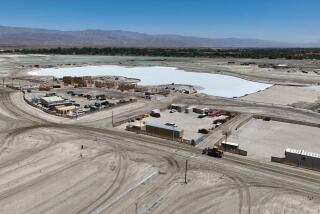Restoring of Spread Gets Final Touches : History: State budget provides funds for work on Los Encinos State Historic Park in Encino. Area is all that remains of once-vast sheep ranch.
For years, state park officials, history buffs, Eagle Scouts and others have been helping to restore a leafy, five-acre spread in Encino which is all that remains of a vast sheep ranch run by two shrewd Basque brothers in the last century.
Now the final touches are about to be applied to Los Encinos State Historic Park. The state budget recently signed by Gov. George Deukmejian includes $115,000 to finish restoring a 117-year-old bunkhouse at the park where ranch hands once ate and slept.
Park officials plan to refurbish the limestone-walled bunkhouse, named Garnier House after the Basque brothers who built it in 1873, as a small museum and visitors center. Work on the house will take about four months to complete, once the money has been allocated. Exhibits will explain the rich history of the ranch, which once covered 4,400 acres and was at various times used to raise longhorn cattle, sheep, wheat and barley.
“We have lots of people who come here and ask, ‘What is this place all about?’ ” said Russ Kimura, a state park ranger.
“It’s probably the most historic piece of land in the San Fernando Valley besides the San Fernando Mission.”
Park planners also hope to display some of the more than 1 million bones, spearheads, cooking pots and other artifacts unearthed in 1984 at the “Lost Village of Encino” across Ventura Boulevard from Los Encinos, the Valley’s only state park.
The village, found during excavation at a bank construction site, is believed to be the Gabrieleno Indian village described in the 1769 diary of a Spanish priest who was with the first party of Europeans to explore the San Fernando Valley. Archeologists and researchers using historical records had tried unsuccessfully for years to pinpoint the site.
To step into the park is to step back into the 19th Century. Located directly off bustling Ventura Boulevard, with its whizzing cars and glittering high rises, the park is an oasis of shade and quiet.
In the center is an old adobe house where the Garniers, both bachelors, once lived. Nearby is a large pond, once used for watering stock but now dotted with frisky ducks. Beyond is the bunkhouse. Over it all spreads a cool green canopy of oak and pepper trees, Torrey pines and California holly.
“People, once they discover it, they always return. It’s like they discovered a gold mine,” said Kimura, who relishes telling visitors about his park.
Park officials recently spent $110,000 to make Garnier House safe in the event of an earthquake, and plan to install carpeting, track lighting and other amenities.
One of the few furnishings is a painting of the adobe house donated by actress Sharon Gless, former star of the television series “Cagney and Lacey.” The painting was done by Gless’ father, a relative of the man who inherited the ranch in 1886. Garnier House also is expected to display artifacts unearthed from the site of a tavern once operated by the Garnier brothers, Phillipe and Eugene, across the old horse trail that was once Ventura Boulevard. Park officials have about 100 boxes of tavern artifacts in storage.
The building also will display some of the Lost Village artifacts, which were once the subject of a lawsuit and have been kept for nearly six years in a Huntington Beach warehouse owned by archeologist Nancy Whitney-Desautels, who headed the 100-member team that found them.
The discovery was considered one of the largest and most important archeological finds in Southern California in 30 years. But the artifacts soon became the subject of a legal tussle between Whitney-Desautels and the developer who hired her to conduct the dig, First Financial Group of Encino.
In 1987, Whitney-Desautels filed a lawsuit seeking $1 million she claimed the developer owed her for digging up, cataloguing and storing the artifacts. She refused to release the items for public display until her fees were paid.
About a year and a half ago, Whitney-Desautels’ firm, Scientific Resource Surveys, accepted $450,000 in exchange for dropping the suit. The settlement also provided that Whitney-Desautels could study the artifacts for two or three years.
In a recent interview, Whitney-Desautels said she plans to donate the collection to a museum once she is finished studying the artifacts, probably by the end of next year. She said she and the developer, who owns half the collection, must first agree on which institution should get them.
Whitney-Desautels said Garnier House will be given some of the pieces for permanent display, as long as park officials agree to make the artifacts available to researchers.
Michael Sampson, an archeologist with the state parks department, said a 1987 consultant’s report urged the state not to acquire the entire Lost Village collection. The report said it would be too expensive to display and that the state already possessed artifacts of equal archeological and cultural significance.
Park officials expressed concern recently about an underground garage planned as part of a proposed three-story office complex next to the park. Authorities worried that excavation for the garage might disrupt a natural spring that feeds the park’s duck pond.
But a spokesman for the developers said his firm has decided to dig the garage on another portion of their property, where it will not hinder the spring.
More to Read
Sign up for Essential California
The most important California stories and recommendations in your inbox every morning.
You may occasionally receive promotional content from the Los Angeles Times.










